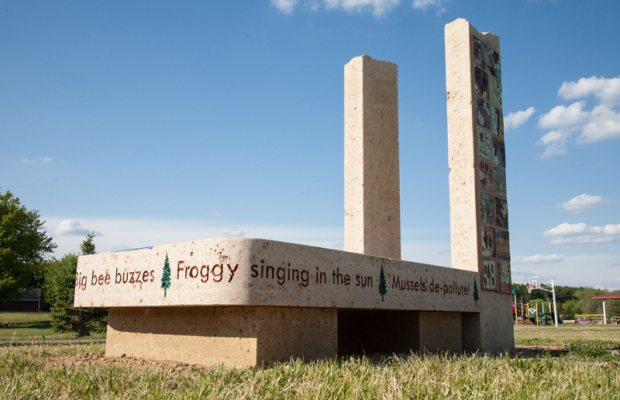Somerset: A Tale of Two Rivers
The Apple River rushes through Somerset, carving a a canyon bordered by 100-foot limestone bluffs. Just downstream, it flows into the St. Croix, which forms the western border of the town. The rivers were a major inspiration for the city’s Art Bench, explains Bruce Martell, a local carpenter who guided the project – with help from a local stone company and a bunch of students who don’t often get such opportunities.
Two limestone pillars stand seven feet above the bench’s surface. They represent the Apple, Martell says, and its towering bluffs. A winding ribbon of blue flows across the bench’s surface, representing the meandering St. Croix.
Those rivers were the highways that the French settlers who founded Somerset used in the 1850s. Connecting to that heritage was important for Martell, a descendant of Somerset settlers who homesteaded at the confluence of the Apple and the St. Croix in 1855.
‘Everyone has a creative spirit’
Connecting with the community was an important aspect for the young people involved, recalls Dave Folkert of Somerset School District. “The Bench Project’s core assumption is that everyone has a creative spirit. This was an opportunity for Somerset residents to better understand how abilities outweigh disabilities,” Folkert says.
The students involved were all from the district’s alternative or special education programs. They don’t participate in many extracurricular activities because of economic reasons, working parents who are unavailable, or they don’t fit into existing programs.
But working on the Art Bench gave them a chance to show what they can do, and an opportunity to expand their interpersonal skills.
“This is a group of kids usually on the fringe, who don’t often get the opportunity to be leaders. When we jumped into this project, one of my goals was to put them in the role of being a leader. I saw a transformation, the confidence that they received by having that role,” says Folkert.
Exploring their heritage and their home
To express the participants’ sense of place, the students, their teacher and the artist dove into the history and nature of the St. Croix Valley.
They visited Martell Landing – the site where Bruce’s ancestors first built a cabin in the early years of the region’s logging boom – now a nonprofit environmental learning center. They collected natural objects from the banks of the Apple River and imprinted them on tiles which were affixed to the bench. They toured the recently-finished Art Bench in St. Croix Falls. And they visited Rivard Stone’s quarry, where the material that would become their bench was excavated.
Martell says it was clear from the beginning that the bench should be constructed with local limestone from Rivard Stone. Rivard ended up not only providing the stone, but exceeding the group’s expectations.
“Rivard did things we didn’t even know was possible, like inscribing the poem the kids wrote around the edge of the bench,” says Martell.
Built to last
Using the local limestone not only connected the bench to Somerset’s geology, but means the bench should stand for many future generations.
It also means that more than a ton of cement was needed for the footing, to make sure the bench doesn’t sink into the earth or tip over.
Folkert designed a plywood box to form the footing, and the older students involved did a lot of the digging.
“The kids had a little sweat equity into the thing. When you do something like that, when you work hard, you can appreciate it more. That stone is going to be there for a long time.”
At least 100 people came to the bench’s dedication in October 2008. In the crowd were several proud students, and a carpenter whose own descendants might someday sit on the bench, just as he today visits the nearby 150-year-old home of his ancestors

